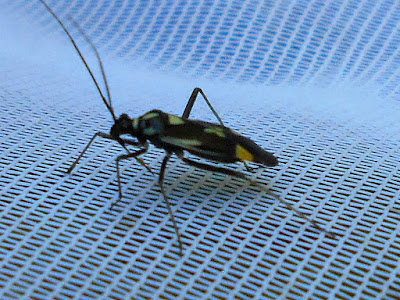Today's butterfly was a Brimstone, Gonepteryx rhamni, and it was nectaring at bramble blossom. When resting on, say, a lime tree leaf, they are quite hard to spot; when in flight it is different.
 |
A brimstone butterfly visits bramble blossom. Kentle Wood, Daventry.
10 June, 2017
|
I made my way to the colony of Common Spotted Orchids to confirm that the had not been damaged; the placement of my feet had to be carefully chosen for in fact the patch seems to have spread. Some of the flower spikes were very robust and I just hope that a casual dog-walker doesn't decide that they'd look nice in their garden!
 |
Some of the spikes on the Common Spotted Orchid were very robust.
Kentle Wood, Daventry. 10 June, 2017
|
They would certainly not take a clump of Hedge Woundwort, Stachys sylvatica. Attractive though the red-purple flower spikes are, the unpleasant smell of the leaves when handled is distinctly off-putting. It doesn't deter bees and they are enthusiastic visitors.
 |
Hedge Woundwort - a good bee plant. Kentle Wood, Daventry.
10 June, 2017
|
A plant of White Clover, Trifolium repens, had white patches on the leaves. These were the work of a fly, Agromyza nana; in this context 'nana' means 'dwarf', and if you live much of your life inside a clover leaflet you can't be over-large. Not an exciting record I agree but it is my solemn duty to report these matters.
 |
| White Clover leaves mined by Agromyza nana. Kentle Wood, Daventry. 10 June, 2017 |
I've not recorded many true bugs this year and those I have seen have been commonplace. However, being commonplace does not render them unattractive. A specimen of a myrid bug, Grypocoris stysi, found itself in my net and was quickly released before I'd realised that my photograph was poor.
 |
Grypocoris stysi is a very common bug even in many gardens.
Kentle Wood, Daventry. 10 June, 2017
|
Scorpion flies may apparently cause alarm because the males have a vicious looking 'sting' at the rear of the abdomen. In fact it is nothing of the sort. It is the genitalia or technically, in human terms, the 'meat and two veg'. At one time it was thought that the patterning on the wings was sufficient to distinguish the species but it is now realised that the aforementioned genitalia, whether male or female, need to be dissected under the microscope. This, with practice, is not as difficult as it sounds but this specimen was a female and these are, in my experience, a little more tricky. Nevertheless this was identified turned out to be - surprise, surprise - Panorpa communis, arguably the commonest of Britain's three known species.
 |
A female scorpion fly. This one is Panorpa communis. Kentle Wood,
Daventry, 10 June, 2017
|
And that was about it, except for the small matter of about fifty insects to be identified once I got home. The total number of species recorded continues to climb steadily and now begins to approach the figure I was hoping for this site. Currently the figures are: 44 flowering plants and 401 invertebrates, including 23 spiders, 50 bugs, 33 butterflies/moths, 80 beetles and 153 diptera (two-winged flies).
Tony White. E-mail: diaea@yahoo.co.uk
Tony White. E-mail: diaea@yahoo.co.uk
No comments:
Post a Comment